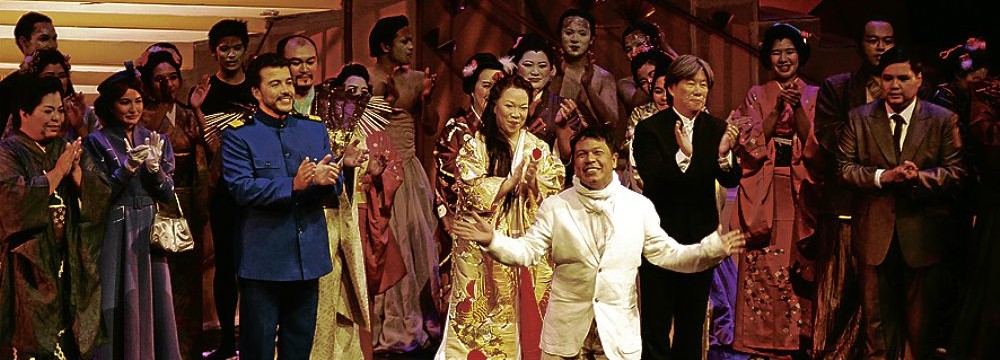Manila’s music lovers came in droves to the Cultural Center of the Philippines the other weekend to watch “Madama Butterfly,” one of the best-loved operas of Giacomo Puccini.
The opera was last seen in the CCP in 1994. Thanks to the big effort the CCP is undertaking to “revive” opera production this year, the Puccini ouevre had been restaged. Two months ago, “La Traviata” was mounted. This month, the CCP will stage Rossini’s “The Barber of Seville.”
Collaborating with CCP in “Butterfly” was MusicArtes, Inc. Extending a warm welcome to the audience and expressing thanks to the sponsors, Josie Tan, chair of MusicArtes, said that by collaborating with the CCP, the foundation hoped to sustain opera productions.
The collaboration was reflected in the cast, which was a coming-together of singers from Japan, Mexico, Singapore and the Philippines.
Director Anton Juan departed from the usual tragic treatment of the opera, lacing it with a positive outlook, letting hope eclipsed tragic resignation that usually capped the productions of “Butterfly” and which sent viewers home with a heavy heart.
Philosophically, the upbeat ending seemed to posit that tragedy was a little death that should not stop people from hoping for the best. This finds relevance in countries like the Philippines that have experienced colonization.
Tradition and novelty

Composed in 1904, “Madama Butterfly” was kept in the style of the verismo opera of the late 19th century, situated in a contemporary social setting, about a Japanese geisha who fell in love with an American naval lieutenant in 1900. It was a time when America was making its presence known in the Far East, keeping up with European countries’ colonial adventures in the region, which they pursued mainly for economic reasons.
Juan kept the same verismo orientation but got out of the box, handling the opera with novelty. Colonial love as symbolized by the pinning down of a butterfly and encasing it in a glass, and as practiced by people of a different culture beyond the shore of Nagasaki and the Asian region, ceased to be a purely Japanese experience, becoming also a Philippine affair, realistically encapsulated in the phrase “hanggang pier lang,” (literally “until the pier”), which our local geishas encountered after Liberation when their American GI lovers left them behind.
Lt. Pinkerton (Mexican tenor Dante Alcala) hinted on the mercenary aspects of love in the arietta in the first act, “Amore o Grillo” (Love or Fancy). His love was merely physical, no less, no more, even if the wings of Madama Butterfly were broken in the process.
Precisely the heroine’s tragedy was brought about by the purity of a love that was innate in her. Juan’s direction underscored this, but he refused to be pinned down by it and instead showed the power of unalloyed love to conquer everything, even pain and remorse. In the end, he let a new butterfly come out of the cocoon with a new pair of wings, fluttering hope for a renewed life.
The director added the image as a poignant coda to the last scene where Madama Butterfly (Japanese soprano Mako Nishimoto) lay on the floor after she committed suicide, her only option to a life dishonored by infidelity.
Dagger dance
After the curtain was lowered and the last note faded, the curtain rose again to reveal Madama Butterfly’s son Trouble, (renamed “Sorrow” in the souvenir program), from whose point of view the story was recounted. He opened Cio-Cio San’s box that contained souvenir items, including the dagger she used for her suicide. Out of the box butterflies fluttered freely out. Then the curtain was brought down again.
Before that, her tragic death was foreshadowed when her fan was soon replaced with a dagger; and her hand gestured butterflies when she intoned her lyrical aria of hope, “Un Bel di Vedremo.”
There were also the highly creative visualization of the interlude of the last act, which Juan transformed into a dream sequence to prefigure the “kidnapping” of Sorrow, and Cio Cio San’s eloquent fan/dagger dance.
Contrasting this was the choreography of the human sets wrapped in white garment (in lieu of white make-up) in characteristic butoh, the Japanese contemporary dance born after the bombing of Nagasaki.
Done in slow motion, the dance was eerie; it was a transmutation of different forms, with the dancers folding up like origami, then metamorphosing into urchin-like figures with magical lighted spikes.
Traditionally this section would simply be listened to, showing Butterfly viewing from the holes of the window till the dawn broke through.
All details became active elements that cohered in driving home the theme of the opera—the conflict between Eastern and Western ways of life, which claimed Madama Butterfly as victim and offering.